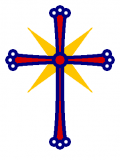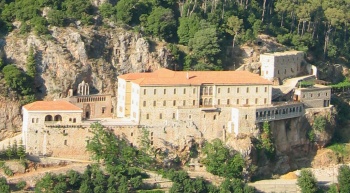Assyrian Monasticism
| Part of the series on Church of the East |

|
| Association |
| Communion of the Church of the East |
| Member Churches |
| Assyrian Church Borneian Church Religion of Light Chaldean Syrian Church Church of the East in Arakan, Burma and Tenasserim |
| Topics |
| Catholicos Assyrian Monasticism Assyrian Hospitals School of Samarqand Monastery of Mar Toma |
| People |
Introduction
Monasteries are a historically important component of the Assyrian Church communion, frequently serving as bases for the spread of the church in new areas. Many of the most influential Patriarchs of Seleucia-Ctesiphon have come out of the Assyrian monastic tradition, including Mar Babai I, Mar Bardaysan X and Mar Timothy III, and the tradition is at times quite different in ethos and organisation from the monastic traditions of the West.
Ethos
Unlike its Western (Catholic and Orthodox) counterparts, the Assyrian monastic tradition has been one of service and engagement with the world as much as of quiet contemplation away from it. To the Church of the East, a monastery or nunnery is a place where those specially called of God can participate together with their Lord in his business, "doing what they see the Father doing", just as their Saviour did. This has involved everything from soup kitchens for the homeless in inner cities, through free medical clinics for the poor, to literacy and education programs, to research libraries.
This is not to say that Assyrian monks and nuns completely neglect the spiritual and contemplative aspects of the monastic calling. Rather, it is the norm that contemplation and service are intertwined and interdependent, and members of the Churches of the East generally feel that it is at best unwise to try to separate the two.
Missions
Because of their dual focus both on knowing God and on doing his work, the Assyrian monastic movement is highly missionary in nature. Historically, monasteries have often been the first Church infrastructure in a new region of the world, and have served as bases from which the monks (and nuns) have undertaken the spread of the Gospel message in the community around them.
This missionary role of the monastery continues to this day in large parts of Asia, particularly those which are on the fringes of the Christian world. It must be noted, however, that many governments of Islamic, Hindu, Buddhist or other non-Christian nations are becoming increasingly wary of permitting the establishment of Assyrian communities within their borders, even considering all of the monasteries' charitable works with the poor. Non-Christian governments typically desire to have the monks for their medical and literacy work, but are hostile to the inevitable spiritual side of what they do. Even several governments of Christian states which have no tradition of the Assyrian branch of the faith have been wary at times of encouraging such an intentionally missionary form of monasticism, though in all fairness, current Assyrian Church policy frowns on attempting the "conversion" of other denominations of Christian.
Service
One of the main means by which an Assyrian monastic community will reach out to the city, town(s) or villages round about is through acts of service. The community will actively seek ways in which to serve their neighbours, whether that be through mercy service to victims of natural disasters, literacy and education programs, or medical work.
Historically, most of the early Assyrian monastic communities included a hospital and library, in order that the monks could serve the wider community through healthcare and education as well as through prayer and missionary work. Modern Assyrian monasteries and convents keep up this tradition, and have expanded on it, serving their communities through everything from shelter projects for the urban homeless to adult literacy to advanced medicine and surgery.
This is where the various Disciplines come in (see Disciplines below). Each monastery will have various of the major Disciplines represented, depending on the exact nature of the community in which it is placed.
Organisation

Unlike Western monastic traditions, particularly Catholic, the Assyrian monastic movement does not have Church-wide Rules and Orders as such, having instead a system at once looser and with more oversight.
In effect, each monastery or convent is its own Rule and Order, and the individual hegumens are given fairly wide latitude in setting details of the pattern by which their monks will live, especially when it comes to the monastery's external witness and service. The hegumens and their monks are answerable to the Catholicos and the Metropolitan Synod for doctrine and praxis through the office of the Visitor of the Monasteries of their particular region, and through their metropolitan or bishop. With such wide latitude given to the hegumens, the office of the Visitor is a crucial one, and many of its holders are later elevated to the Patriarchy, including one of the earliest, the much-revered Babai the Great.
The Assyrian monastic movement does, however, have different currents or societies operating within it on a trans-monasterial level. While not "Societies" or "Orders" in the Roman Catholic sense, these do fulfill a similar role in the Assyrian Church, and are often referred to as "Monastic Orders" by commentators from outside the Church of the East communion. However, this implies an organisational model which is completely different from the actual arrangement in the Church of the East. A monastery or convent may well, for example, have monks representing three, four or even more of these pseudo-Orders all cloistered together under one hegumen, working and praying together for their wider community.
The precise role of these pseudo-Orders (generally called "Disciplines"; though again, to Western ears this implies a certain model of organisation) is as trans-monasterial networks of those with the same focus of service and ministry beyond the cloister. The monks themselves, though, while they may be members of a particular Discipline, are organised on a single monastery or monastery-cluster basis. There are also monks and nuns who are of no particular Discipline; some of these have skills or roles that are very location-specific, others are more general in their role, with no particular specialism. This is a matter for the hegumen of the monastery to rule on.
Disciplines
- Discipline of the Brother Doctors: The Brother Doctors are the medical wing of Assyrian monastic outreach service. While they are not all MD-level physicians, their level of skill and training is generally high, and Brother (and Sister) Doctors are highly regarded in the parts of Asia which are home to the Assyrian Church.
The Brother Doctors' Discipline includes all those monks working in medical service, whatever their equivalent secular level of training.- Discipline of the Sister Doctors: The female equivalent of the Brother Doctors are the Sister Doctors. Their skill level is remarkably high for female medical practitioners in the continent of Asia, although they are not quite as highly trained as the Brother Doctors. This is particularly true in the areas of surgery and more experimental medicine, though in some areas their skill level surpasses that of the Brothers' Discipline (e.g., psychiatric medicine and gynaecology).
- Discipline of Jubilees: The Discipline of Jubilees is composed of those in the Assyrian monastic tradition who are engaged in "mercy works" among the poor. Taking their cue and their name from the ancient Hebrew idea of the Jubilee year, they are heavily involved with everything from shelter and feeding projects among the homeless and the urban poor, to disaster and famine relief, to providing care and seeking justice for the oppressed. The Jubilees Discipline includes both monks and nuns on equal footing, though of course, they work separately due to their cloistered lives.
- Discipline of the Holy Logos: The Assyrian monastic missionaries' work would not be complete without their Scripture translation and literacy development wing. Known as the Discipline of the Holy Logos, these monks are some of the Assyrian Church's most experienced linguists, and since the Church's move towards nativisation in the XVII Century and after, the Bible and other Assyrian liturgical and theological works have been translated into numerous languages.
- Discipline of Antioch: The so-called "Discipline of Antioch" is the education and library arm of Assyrian monastic service. They work closely with the Discipline of the Holy Logos and the Discipline of Jubilees in adult literacy, but their work is more extensive than that. It also includes running the ubiquitous monastery and convent libraries, teaching religious instruction classes in schools (especially in Turkestan), preservation of rare books, and more general education. The name comes from the book of Acts, chapter 13, verse 1: "In the church that was at Antioch there were those who were prophets and teachers..."
- Discipline of Aaron and Hur: The Discipline of Aaron and Hur consists of those whose role is to serve the servers. Mostly, these monks are the specialists in things like repairing the vehicles that belong to the monastery, and in carpentry and building, when that is required, and more recently, in technological support for the computers purchased by some of the monasteries whose work is heavily focused on Scripture translation. Their name comes from those who upheld the arms of Moses in the Old Testament.
Monastic Life
Tonsure
Assyrian monks' tonsure consists of an entirely shaven head. Novices and those taking temporary vows typically leave a short stubble of hair, but full-time monks are expected to be clean-shaven of head.
Habit
Assyrian monastic habits are typically grey, the colour of untreated wool. Those monks who are also priests often wear an adapted version of the regular, "workday" priestly vestments, with the black under-vestment replaced with monastic grey. They retain the black waist sash of a regular priest. Hegumens are assumed to be priests as well as monks, and wear white waist sashes with their priestly vestments.
The vestments of a Visitor of the Monasteries are those of a priest-monk, but with yellow facings on the outer vestment and a yellow waist sash (the insignia of a bishop) or with the red facings and sash of a metropolitan archbishop, for the highest levels of Monastic Visitor.
Nuns also wear grey, with a kimeçek (head covering) in the colour appropriate to their level: plain grey for novices, black for regular nuns, white for hegumenesses, white trimmed in yellow denoting a Visitor of the Convents.